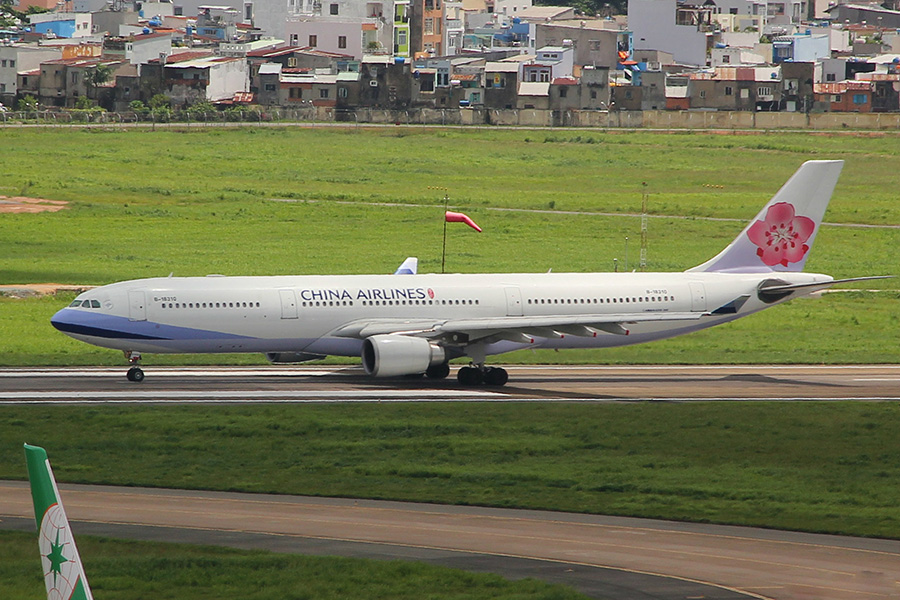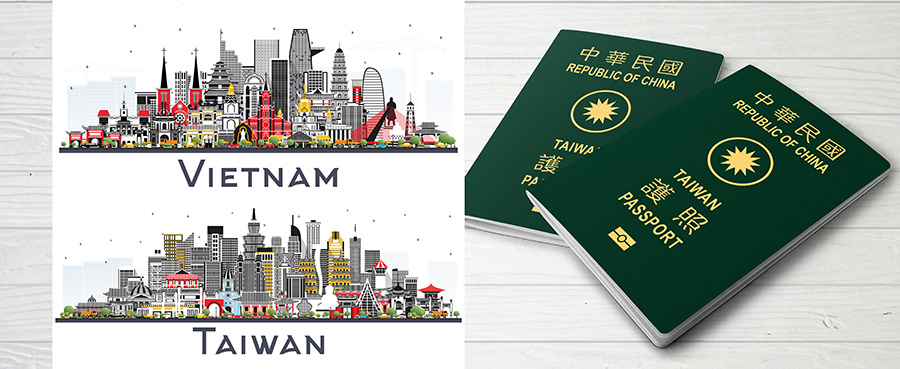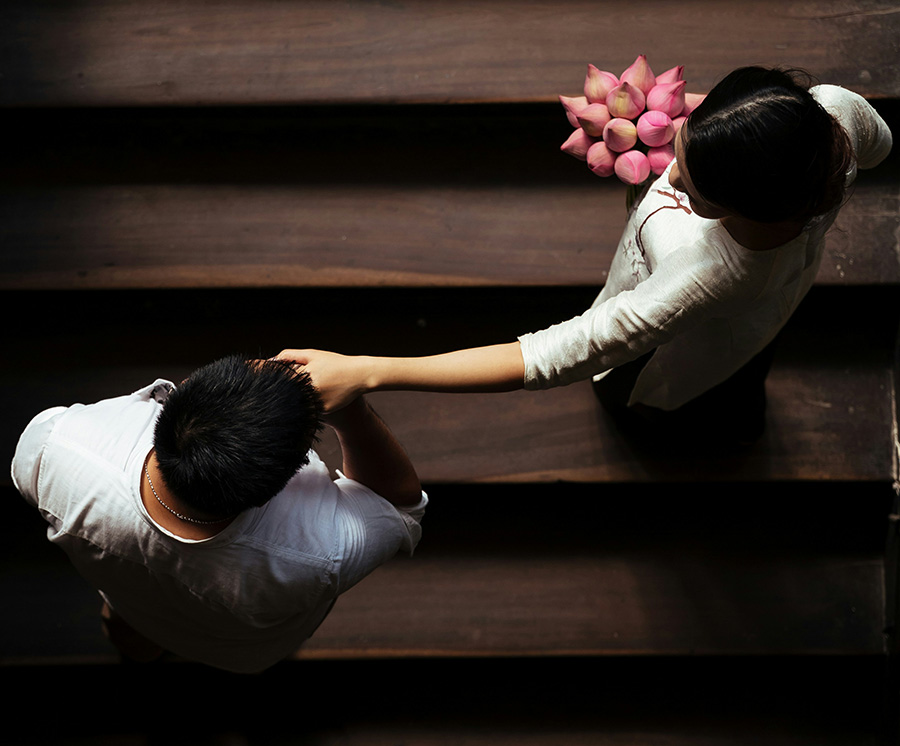
A substantial number of Vietnamese married women migrated with their spouses to Taiwan during the 1990s. Nevertheless, empirical evidence indicates that there is currently a growing trend among Vietnamese-Taiwanese couples to reside in Ho Chi Minh City, Vietnam. Employing the approach of cultural variables and rational choice, this study presents findings from 33 interviews conducted with multicultural families, encompassing the life stories of 12 women, 10 husbands, and 11 children, to take into account various aspects within family dynamics, as well as considerations of nationality and citizenship. Only the main findings of the paper would be discussed here in the first or two papers, while the second paper would present results of the interviews in more details.
The findings indicate that setting up multicultural households in Ho Chi Minh City predominantly originate from voluntary decisions, driven by love and a desire for harmonious cohabitation, and exhibit a strong sense of empathy, harmony, and adaptability in terms of linguistic and cultural practices within their domestic activities. Children born into legally recognized multicultural households often have the opportunity to acquire dual citizenship; however, the level of understanding of citizenship rights varies depending on the specific circumstances and context surrounding each instance. Foreign spouses of Vietnamese citizens residing in Vietnam encounter some disadvantages, including issues pertaining to their residency entitlements.
Introduction
The phenomenon of multiculturalism and the emergence of multicultural families are unavoidable and results of globalization. In the US, it was anticipated that multicultural households there will expand by 213% between 2000 and 2050, and that 8% of those 213% will be Asian-Americans (Kim, 2022). Korea, Taiwan, and Singapore have been at the forefront of globalization, and multicultural families there have grown. In Korea a total of 1.09 million persons or 2.1% of Korea’s total population are members of multicultural households (Lee, 2021). In Taiwan, the proportion of married immigrant women from Southeast Asia in Taiwan’s population is at approximately 2.4% (Wu, 2023). Furthermore, it is worth noting that cross-border marriage constituted a significant proportion, ranging from 10% to 39%, of all marriages in Korea, Taiwan, and Singapore in the year 2015, as reported by the International Organization for Migration (Ahn, 2022).

In 2022 Taiwan 113,000 Vietnamese women arrived in Taiwan through marriage (Wu, 2023), and Vietnamese take second position in terms of the number of foreign brides of Taiwan. As such, the trend in the past years of scholarly research has been around the subject of Vietnamese women who are married and subsequently migrate to Taiwan, following their Taiwanese spouses.
A discernible inclination among individuals in recent years is for these multicultural families involving Vietnamese to migrate to Vietnam for the purpose of employment, marriage, and long-term residency (Ha et al., 2021). HCM City has become a focus of settlement for Taiwan-Vietnam families. Reasons? HCM city is a highly sought-after destination for numerous Taiwanese enterprises and a significant influx of Taiwanese employees. Its international schools 1 and the location of mutual help possible with a high concentration of Taiwanese population meant that many Taiwan-Vietnamese families have chosen HCM City to settle in.
The study that is the subject of this introduction employed a cultural variable and rational choice approach to reframe knowledge of Vietnamese-Taiwanese multicultural households. The primary inquiries addressed in this study were as follows: (1) What are the size and primary abodes of Vietnamese-Taiwanese multicultural families in Ho Chi Minh City? (2) What are the elements that influence daily life within multicultural Vietnamese-Taiwanese families, specifically focusing on language, communication, and dietary practices? (3) How do they address and resolve cultural disparities? and (4) How do nationality and citizenship impact on the lives of multicultural families residing in Vietnam? Because of the length limitation placed on each article of this journal, this study is presented here in two installments in this journal.
The research hypothesis that we have formulated encompasses the following. (1) the choice of location for settling down by these families will depend on work availability, schools for children, and the living environment. (2) Opting to reside and pursue professional advancement in the wife’s native city, the husband faces a greater number of drawbacks in terms of residential conditions, cultural assimilation, and available activities. Additionally, the wife experiences a reduced or nonexistent burden to adhere to traditional gender norms; 3) Between Vietnamese and Taiwanese they exhibit linguistic disparities and numerous cultural commonalities. Consequently, Vietnamese-Taiwanese multicultural families may encounter certain challenges pertaining to communication and dining practices. However, these issues are unlikely to escalate into significant disputes; (4) The resolution of cultural disparities can be progressively enhanced through the cultivation of comprehension, assistance, the establishment of reciprocal cultural influences, and the gradual development of harmony within romantic partnerships; (5) Multicultural couples may initially experience a citizenship advantage by residing in one partner’s hometown. The residency policy for foreign spouses in Vietnam has a significant impact on their lives and families within the country.
The research offers several practical and scholarly contributions. Firstly, the study focuses on the phenomenon of marital migration and examines the decision of individuals to settle in Vietnam, a country that is primarily recognized as a place of “emigration” rather than “immigration”.
The following are the main findings of the paper.

Factors promoting Taiwanese-Vietnamese inter-marriages
Taiwan’s economic relationship with Vietnam, since 1989, has been the foundation and that precedes social relations. 2 (Wang & Bélanger, 2008). From 1995 to July 2005, 89,085 Vietnamese individuals participated in face-to-face interviews at the Taipei Economic and Cultural Office in Vietnam to access their marriage eligibility, most of which were women (Huệ, 2006) Taiwan has consistently maintained its position as the leading destination for Vietnamese brides. Geographical proximity and cultural and linguistic similarities also played a part in promoting Taiwanese-Vietnamese inter-marriage. In addition, Vietnamese males looking for marriage partners faced the challenges of high expectations of Taiwanese women, better educated and an economic force in themselves. (Le-Phuong et al., 2022). Vietnamese women on the other hand are driven to improve their economic well-being, and the ease of entry into Taiwan given a somewhat lenient and inclusive Taiwanese approach (Xuan et al., 2022) have promoted Taiwanese-Vietnamese marriages.
Prejudice about Vietnamese women who marriage-migrate to Taiwan
Vietnamese women married to Taiwanese and migrated to Taiwan frequently encountered discrimination after emigration. They were typically of a young age, predominantly from rural regions, possessed little educational achievements, and were socio-economically disadvantaged (Xuan et al., 2021). A significant proportion of them actively worked to service financial obligations of families in both countries (Wu, 2022). Taiwanese men in such marriages tend to be somewhat older (often between the age range of 30 to 60 years), and most of them have secure employment.

Because the majority of Vietnamese women often meet their prospective spouses via commercial marriage intermediaries, coupled with the above characteristics, Vietnamese marriage immigrant women are predominantly depicted by Taiwan’s public media as victims of the patriarchal system. They would be either materialistic individuals who utilize migration as a method of financial gain or as “runaway brides” who divorced their Taiwanese husbands after acquiring citizenship and accumulating sufficient wealth (Wu, 2023). The state played a role in furthering stereotypes. (Wang & Bélanger, 2008).
Language and communication
Most offsprings of such marriages tended to partially or wholly abandon their mother’s mother tongue, and selected Mandarin as the operating language at home. This situation could have been driven by a need for English so that children would plug into the global economy. Otherwise, when privilege is given to the Vietnamese language, it is similarly due to economic interests specific to the family (Cheng, 2017). Meanwhile the new immigrants are handicapped in job search and may have faced discrimination due to low proficiency in the Chinese language. (Wu, 2023) Other research have also shown Vietnamese women actively working to improve their situation in income, language, and the education of their children. (Chen, 2011)
Nationality and citizenship awareness
Two studies conducted by the Taiwanese government in 2004 and 2008 revealed that 50-70 percent of immigrant wives gave birth after arriving in Taiwan. Some contend that children are born within the first few years of moving to Taiwan. The correlation between elevated rates of naturalization and birth among married immigrant women in Taiwan suggests a connection between the process of obtaining citizenship and the transition into motherhood (Cheng, 2017). The birth of a child can be seen as evidence supporting the authenticity of the marriage between a Taiwanese individual and their foreign spouse, and facilitates the expeditious acquisition of residence or citizenship for married immigrant women, which earns citizen treatment (Chiu & Yeoh, 2021). By December 2014, the majority of migrant women who entered into marriage with Taiwanese nationals eventually acquired Taiwanese citizenship. Vietnamese women were the biggest subgroup (75%) within this population of such 145,441 migrant women/new citizens. Vietnamese moms have the expectation that their offspring will develop a sense of Taiwanese identity during their upbringing; while some mothers express a desire for their children to embrace a bicultural identity, none of the respondents indicated that their children will ultimately identify as Vietnamese (Chen, 2011).

Emerging perspectives on Vietnamese brides in Taiwan
In recent years, there has been a noticeable shift towards a more favorable discourse around the marriage of immigrant women and the subsequent implications for their children within the context of Taiwan. This is intricately connected to social movements that advocate for the protection of the human and cultural rights of individuals who are migrants and have entered into marriage, as well as their offsprings (Hsia, 2021). In particular, the impact of the New Southern Policy (NSP) adopted by the Taiwanese government in 2016 to strengthen ties between Taiwan and Southeast Asian nations has been significant. It has been argued that the NSP fundamentally transformed the dynamics of the interaction between immigrant women and the Taiwanese government. Now, these new immigrants are not just urged to sustain frequent communication with their biological relatives residing in Southeast Asia, but are also able to transmit their cultural and linguistic legacy to their offspring of mixed racial backgrounds in Taiwan (Cheng, 2021). The second generation born of married migrants is reportedly the backbone of the NSP, and they are increasingly seen favorably by the Taiwanese government as it transitions its perception of cross-border marriage from a “social issue” to a “social asset” (Hsia, 2021).
This is the end of the first part of this huge and informative research paper of foreign brides from Vietnam in Taiwan. The second part of in the next article in this series of this journal will provide material from the fieldwork conducted for this study. In the second part/paper, the main findings cover the Vietnamese-Taiwanese families’ preferred areas of residence in HCMC, the family members’ levels of proficiency in Vietnamese and Chinese, the daily cuisine choices, and the dilemma of the families, especially the children, in dual citizenships and identities.
Phan Thi Hong Xuan, Ho-Hsien Chen, Vo Phan My Tra
The authors are: Phan Thi Hong Xuan (University of Social Sciences and Humanities – Vietnam National University Ho Chi Minh City), Ho-Hsien Chen (Taipei Economic and Cultural Office in Ho Chi Minh City), and Vo Phan My Tra
References
Ahn, S. Y. (2022). Matching across markets: An economic analysis of cross-border marriage. University of Illinois at Chicago. https://syahn.people.uic.edu/JMP_SA.pdf
Bélanger, D., Hồng, K. T., & Linh, T. G. (2013). Transnational Marriages between Vietnamese Women and Asian Men in Vietnamese Online Media. Journal of Vietnamese Studies, 8(2), 81–114. https://doi.org/10.1525/vs.2013.8.2.81
Berry, J. W. (1997). Immigration, Acculturation, and Adaptation. Applied Psychology, 46(1), 5–34. https://doi.org/10.1111/j.1464-0597.1997.tb01087.x
Berry, J. W. (2005). Acculturation: Living successfully in two cultures. International Journal of Intercultural Relations, 29(6), 697–712. https://doi.org/10.1016/j.ijintrel.2005.07.013
Chen, E. C.-H. (2011). Taiwanese-Vietnamese transnational marriage families in Taiwan: Perspectives from Vietnamese immigrant mothers and Taiwanese teachers [Doctoral thesis]. University of Illinois.
Cheng, I. (2017). She cares because she is a mother: The intersection of citizenship and motherhood of Southeast Asian immigrant women in Taiwan. In International Marriages and Marital Citizenship. Routledge.
Cheng, I. (2021). Motherhood, empowerment and contestation: The act of citizenship of Vietnamese immigrant activists in the realm of the new southbound policy. Citizenship Studies, 25(7), 975–992. https://doi.org/10.1080/13621025.2021.1968688
Chiu, T. Y., & Yeoh, B. S. A. (2021). Marriage migration, family and citizenship in Asia. Citizenship Studies, 25(7), 879–897. https://doi.org/10.1080/13621025.2021.1968680
Ha, P. T. T., Thuy, H. T., Thanh, T. V., & Hang, T. T. (2021). Vai trò giới trong gia đình phụ nữ Việt Nam kết hôn với lao động nước ngoài. Tạp Chí Khoa Học Hội Phụ Nữ, 2021(2), Article 2.
Hsia, H.-C. (2021). From ‘social problems’ to ‘social assets’: Geopolitics, discursive shifts in children of Southeast Asian marriage migrants, and mother-child dyadic citizenship in Taiwan. Citizenship Studies, 25(7), 955–974. https://doi.org/10.1080/13621025.2021.1968687
Huệ, P. T. (2006). Phụ nữ Việt Nam lấy chồng Đài Loan: Hiện trạng và một số định hướng chính sách—Tài liệu, Luận văn. Xã Hội Học, 2(94), 74–83.
Kim, K. (2022). A Study on Parenting Experiences of Multicultural Families with Disabled Children in Korea. Social Sciences, 11(9), Article 9. https://doi.org/10.3390/socsci11090381
Lệ, T. T. (2022). Báo cáo tổng hợp kết quả khoa học và công nghệ nhiệm vụ Người nước ngoài di cư đến thành phố Hồ Chí Minh—Thực trạng và giải pháp. Viện Nghiên cứu Phát triển thành phố Hồ Chí Minh.
Lee, H. (2021). Gov’t to conduct survey of multicultural families—The Korea Times. https://www.koreatimes.co.kr/www/nation/2021/08/119_313183.html
Le-Phuong, L., Lams, L., & Cock, R. D. (2022). Social Media Use and Migrants’ Intersectional Positioning: A Case Study of Vietnamese Female Migrants. Media and Communication, 10(2), 192–203. https://doi.org/10.17645/mac.v10i2.5034
Redfield, R., Linton, R., & Herskovits, M. J. (1936). Memorandum for the Study of Acculturation. American Anthropologist, 38(1), 149–152.
Sam, D. L., & Berry, J. W. (2010). Acculturation: When Individuals and Groups of Different Cultural Backgrounds Meet. Perspectives on Psychological Science, 5(4), 472–481. https://doi.org/10.1177/1745691610373075
Scott, J. (2000). Rational Choice Theory. In Understanding Contemporary Society: Theories of the Present (pp. 126–138). SAGE Publications Ltd. https://doi.org/10.4135/9781446218310
Sở Tư pháp TP.HCM. (2022). Báo cáo kết quả đăng ký khai sinh, khai tử, kết hôn trên địa bàn thành phố Hồ Chí Minh năm 2022.
Tang, W. A., Anna, W., & Chen, P. (2013). Tactical resistances in daily politics: How do battered Vietnamese wives negotiate family and state tightropes in Taiwan? In Migration to and From Taiwan. Routledge.
Trường Quốc tế Đài Bắc tại TP.HCM. (2023). Thống kê số học sinh là con em của gia đình đa văn hóa Việt—Đài đang theo học tại trường Quốc tế Đài Bắc tại TP.HCM giai đoạn 2010-2023.
Văn phòng Kinh tế và Văn hóa Đài Bắc tại thành phố Hồ Chí Minh. (2023). Thống kê số cặp đôi Việt—Đài đăng ký kết hôn tại Văn phòng Kinh tế và Văn hóa Đài Bắc TP.HCM từ năm 2015-2022.
Wang, H., & Bélanger, D. (2008). Taiwanizing female immigrant spouses and materializing differential citizenship. Citizenship Studies, 12(1), 91–106. https://doi.org/10.1080/13621020701794224
Wu, Y.-L. (2022). Entrepreneurship Experiences among Vietnamese Marriage Immigrant Women in Taiwan. Sustainability, 14(3), Article 3. https://doi.org/10.3390/su14031489
Wu, Y.-L. (2023). Negotiating and Voicing: A Study of Employment Experiences among Vietnamese Marriage Immigrant Women in Taiwan. Social Sciences, 12(2), Article 2. https://doi.org/10.3390/socsci12020094
Xuan, P. T. H., Huyen, L. N. A., & Nghia, P. H. (2021). Overview of Studies on Multicultural Families between Vietnamese and Foreigners in Vietnam. Hor J. Hum. & Soc. Sci. Res, 131–138. https://horizon-jhssr.com/view-issue.php?id=108
Xuan, P. T. H., Nghia, P. H., Huyen, L. N. A., Soo, K. M., & Tra, V. P. M. (2022). Research Overview on the Life of Families with Foreign Elements in Ho Chi Minh City, Vietnam. 701–709. https://doi.org/10.2991/978-94-6463-008-4_88
Notes:
- This Taipei International School, overseen by the Taipei Consulate, caters to students from Kindergarten to Grade 12. Notably, approximately 50% of the annual student population consists of individuals from Vietnamese-Taiwanese multicultural backgrounds (Taipei International School, 2023). ↩
- The Republic of China (Taiwan) and the Republic of Vietnam (southern Vietnam) had a diplomatic relationship until the latter’s demise in April 1975. Reunified Vietnam adopted a one-China policy and hence de-recognised the Republic of China as the state ruling China. However, informal economic and political relations have continued after the initial downturn following de-recognition. ↩
